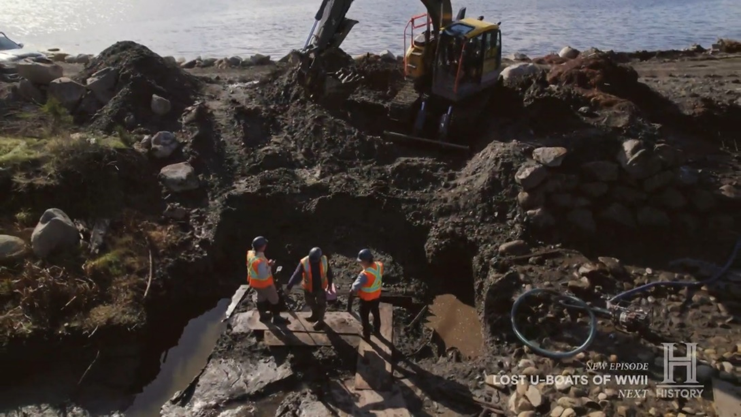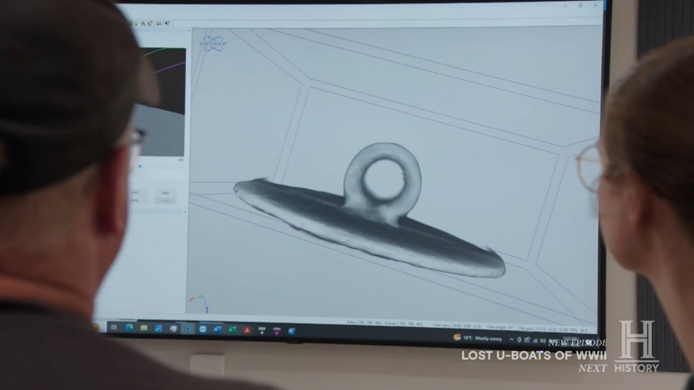SEASON 11, EPISODE 19, “HI HO SILVER” ARTIFACT AND FEATURE ANALYSIS
- Daniel Spino

- Mar 20, 2024
- 5 min read
The Curse of Oak Island – The History Channel
In this week’s episode, “Hi Ho Silver”, we are first taken to the southeast corner of The Swamp, where the Oak Island team consisting of Rick Lagina, Jack Begley and metal detectorist Gary Drayton continue to work at undercovering a structure that has recently been found. They mention that it appears that there is a southern and eastern wall to this structure that is held together in spots by dowels and not fasteners. While exploring the spoils they discover pieces of pottery and a barrel stave which indicates, in the opinion of the Compendium, that some kind of cargo was being loaded and unloaded in this area.
The Curse of Oak Island – The History Channel
We then move to the New Lab where Archeometallurgist Emma Culligan is meeting with some of the other members of the Oak Island team to discuss the large spike found at the center of Lot 5 presented in last week’s episode. The team mentions that it appears to be a unique piece because of where it was found and its size. Emma analyzes the artifact using a CT scan and an XRF scan to garner more information about its shape and consistency. Emma confirms that it is hand forged wrought iron with a high sulfur content with no manganese which indicates an older artifact. It has few impurities and is not a fastener and maybe a tool. Emma can’t pinpoint a date but gives a range of anywhere from 1100 to the 1700’s AD. Considering the artifacts that have been found in proximity to this piece, The Compendium believes it is most likely from the 1700’s.
The Curse of Oak Island – The History Channel
The scene shifted back to The Swamp where Dr. Ian Spooner joins other members of the Oak Island team to give his opinion of what they have discovered at this excavation area. Wooden planks have been found that are very deep and posts that seem to make corners are observed that look like they were made to be obscured because of the depth. He mentions that to build this feature you would have to de-water The Swamp, but the Compendium suspects there was no swamp when this was built. Dr. Spooner mentioned that that he believes these posts and the feature could be related to the Stone Road feature. It is noticed that the posts look to be adze-cut and it is determined that this feature could be historically significant and surveyor Steve Guptill needs to be brought in to document it before they proceed any further.
The Curse of Oak Island – The History Channel
We are then taken to the War Room where researcher John Edwards presented his theory regarding a Freemason/Rosicrucian/Knights Templar association and believes he has discovered information that indicates that masonic code was encoded. He believes this code and information was hidden and suggests that the Ark of the Covenant was buried on Oak Island. Edwards is a teacher from Maryland who stated that he spent the last 30 years studying symbology relating to Freemasonry/Rosicrucianism/Templars. Edwards shows a variety of books that he claims have masonic code hidden in them. He references a Masonic song and refers to portions of it and suggests that the Ark of the Covenant was hidden on Oak Island. The song is listed as Royal Arch Ode (19th Century) with no other information given about it. The Compendium has investigated and learned that the ode was written by James Gates Percival, 1795-1856. Mr. Gates was a writer/poet but worked primarily as a geologist. It appears that Mr. Gates wrote this Masonic Ode but wasn’t a Mason himself. Percival was described as very shy and withdrawn and preferred to be by himself. Most likely this would preclude him from being an active participating member of Freemasonry. Mr. Gates background doesn’t seem to suggest he had any involvement with Oak Island, but he did visit Nova Scotia at one point as a brief advisor to a mine in Londonderry. The Compendium will present a full analysis of this presentation in another article later this week due to the amount of information that was involved.
The Curse of Oak Island – The History Channel
The action shifted to the Lot 5 excavation site near the shore where archeologists, Jamie Kouba and Fiona Steele are continuing their excavation of the area. While working at the site, Jamie discovers what looks to be a gold-plated button. Upon inspection, she believes that it could be from a high-ranking military or naval officer. She said that it’s unlike the other button that was previously found in the area. They continued the excavation and Jamie found another interesting artifact. This appears to be a silver piece. She speculated that it could be a portion of silverware but is very unique and has some decorative aspects on the end. There is then speculation that this could be tied to the theorized silver of William Phips that has been discussed numerous times on the show. It is then mentioned that there was a link between the excavation site and The Money Pit and perhaps this piece originated there. Both pieces are bagged and tagged and sent to Emma for further testing.
The Curse of Oak Island – The History Channel
We are taken back to The Swamp where the Oak Island team that includes Gary Drayton and Jack Begley are continuing their efforts near the shoreline. After going through the spoils, Gary unearths what appears to be an old digging tool that he suspects is a trowel. He said it was between the wood planks in this new feature. He said it was iron and looked to be old. After some more work, they discover what appears to be a very large fastener that still has wood encased around a portion of it. This can be analyzed for the wood and the iron content for possible dating. Jack then looked at some of the wood logs and noticed their cuts and saw evidence of iron in them. All of this evidence was collected and sent for further analysis.
The Curse of Oak Island – The History Channel
Our analysis concludes at the New Lab where Emma meets with some of the other Oak Island team including archeologist Laird Niven. They are there to hear the results of the testing on the button and silver piece discovered at the Lot 5 excavation site near the shore. Emma states that the button is gilded gold and has high levels of phosphorus. It’s believed to be British and from a military or naval officer or gentleman from the 18th Century. Then the Silver piece is shown to be 90% silver and Laird mentions that he’s never seen silver like this in his 40-year career. They are not sure what it is but speculates it could be the end of a tassle or a piece of a knife hilt. The association with William Phips is mentioned again and the scene closes. Until next week.
Good day from the Compendium!
























